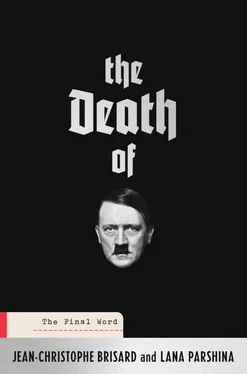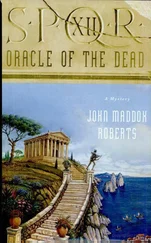Depending on the dose of cyanide and the weight of the individual, their age, their state of health, and whether they have just eaten or not (it has been proven that cyanide acts more quickly on an empty stomach), death is more or less swift. But it always follows intense suffering. The first pains are manifested at the neurological and cardiovascular levels. Severe migraines appear very quickly. Then dizziness, confusion, a sense of inebriation… After that comes the sense of being unable to breathe. Like a prolonged fit of apnoea. Anxiety is added to pain. The individual is seized by general convulsions and then loses consciousness. A few minutes later death comes by cardiac arrest. How long does it take to lose consciousness? It is all a matter of dosage, the type of cyanide, and the mode of its administration. Himmler would have taken fifteen minutes to die after taking his cyanide capsule. That detail was reported by British soldiers who had just arrested him by the Danish border and impotently witnessed his suicide on 23 May 1945. However, the death of the head of the SS also remains surrounded by shadowy areas. Himmler’s autopsy, like the official report of his death, is not declassified even today. Both remain classified as “military secrets” in the British archives. They should not be accessible until 2045, or a hundred years after his death.
It is often noticed that a strong smell of bitter almonds is given off after the use of cyanide. In the episode with the dog Blondi, the witnesses are united in remembering this typical odour hanging in the air. That tenacious smell can linger for a long time. In the case of Hitler and Eva Braun, the Soviet forensic team noticed it during the autopsy. But the bodies had been carbonised and buried for several days: “[…] upon opening of the corpse a marked bitter almond smell was perceived. The conclusion reached is therefore that the death […] was cause by poisoning with a cyanide compound.” [63] Lev Bezymenski, The Death of Adolf Hitler , op. cit., p. 89.
Is it possible that the smell could have persisted for such a long time after the suicide? And particularly that it could have resisted intense carbonisation? Did the Soviet forensic team not exaggerate this theory of bitter almonds in order to confirm the cyanide theory? A theory, as we were able to establish in the Russian Archives, which Stalin preferred because, in his eyes, suicide by poison was a contemptible act for a warlord.
Some eyewitnesses to Hitler’s death mention that famous smell of almonds. Others do not. That incoherence is easily explained. Today we know that the smell is not perceptible to everyone. It is accepted that between 20 and 40 per cent of people are insensitive to the smell. So should we still accept the hypothesis of cyanide in Hitler’s suicide? Might the smell of bitter almonds reported by the witnesses to the suicide not have been caused solely by the death of Eva Braun? In her case, the use of cyanide has never been called into question. Linge remembers seeing traces of pain characteristic of this kind of poisoning on the young woman’s face. In his memoirs, Hitler’s valet adds that he found a small box on the table by the sofa where the two corpses were lying. It was in that box, according to him, that the Führer’s wife’s capsule had been stored. But it is important to note that this box “no longer exists” in the reports on the Soviet interrogations of Linge.
The night of 26–7 February 1946:
Russian investigator:Did you find, on the sofa or somewhere nearby, on the floor, an ampoule or a box of poison that Eva Braun might have been able to use?
Linge:No. There was no trace of poison: no ampoule or box of poison has been discovered by me, even when I came back after cremating the corpses of Hitler and his wife to attend to their personal effects.
More contradictions, more doubts. Was Linge lying when he gave his answers to the officers of the Soviet secret services? Or when he wrote his memoirs? These changes to his story, the constant alteration of details, encouraged conspiracy theories, according to which Hitler might not have died in his bunker and might have been able to escape.
The Soviet investigators also had their doubts. They very quickly identified a flaw in Linge’s scenario. That of establishing the deaths of Hitler and his wife:
Investigators:Which doctor confirmed the death of Hitler and his wife?
Linge:Bormann and I did not call any doctors because it was clear to us that Hitler and his wife were dead.
Investigators:Do you or Bormann have a degree in medicine?
Linge:No. Neither Bormann nor I have a degree in medicine.
Investigators:How in that case were you able to conclude that Hitler was indeed dead? Did you check his pulse, listen to his heartbeat?
Linge:No. We did none of any of that. We just reached the conclusion that he was dead by looking at him.
Investigators: How did you deduce that Hitler’s wife, Eva Braun, was dead?
Linge:We concluded that she was dead only by her appearance. She remained inert. We thought she had poisoned herself.
[…]
Investigators:Were there doctors in the bunker of the Reich Chancellery?
Linge:Yes. There was Hitler’s personal physician, Standartenführer Stumpfegger, and Hitler’s former personal physician, Professor Haase.
Investigators:Why did you not summon those doctors to establish whether they were dead or not?
Linge:I cannot explain why we did not call doctors to confirm the deaths of Hitler and his wife.
Joël Poupon is very familiar with the effects of cyanide. Unlike Linge, he has no shortage of degrees. He is a specialist in mineral analysis in the laboratory of biological toxicology at the Saint-Louis-Lariboisière Hospital in Paris. Philippe Charlier immediately thought of him as the one to help him resolve the mystery of the blue stains found on Hitler and Eva Braun’s teeth. Dr. Poupon’s first reaction to the pictures of those stains was to say “that’s incredible!” in an open manner quite unfamiliar in this rather reserved scientist. Perhaps it was the clarity and depth of that blue that left him anything but indifferent. A thick, almost sombre blue like… Prussian blue. That is the name of this singular colour. A colour created chemically by mixing iron sulphate and potassium ferrocyanide. The blue owes its name to the fact that it was discovered by a German chemist in Berlin in the early eighteenth century. Its shade corresponds to many of the traces left on the teeth stored in the FSB archives. Dark blue– kuanos in ancient Greek–which gave us the word “cyanide.”
As the quotation attributed to the Swiss doctor and philosopher Paracelsus has it, “Everything is a poison and nothing exists without toxicity; it is only the dose that makes a thing not a poison.” For cyanide this is very much the case. If, in everyday language, cyanide is widely associated with a poison that causes sudden death, often used in the shady worlds connected with espionage, in reality this chemical compound is part of our everyday life. Without necessarily putting us in danger. Thus we find cyanide, hydrogen cyanide (HCN), in cherry and apricot stones, and indeed in apple pips. If it is quite rare to eat those stones, we do eat bitter almonds. And they contain a fair amount of cyanide. Luckily, unless we eat them in enormous quantities, our body has no difficulty resisting this natural cyanide.
This compound can also be extracted by chemical methods and produced in different forms: gaseous (used by the Nazis in the gas chambers), liquid, but also in soluble salts. In this last case we talk about potassium cyanide, ammonia cyanide, or calcium cyanide. Was this the case with these teeth? To check, you need only to lay hands on one of these capsules. Not just any capsule: one of those dedicated to senior Nazi dignitaries, the ones that were distributed in the Führerbunker. After a great deal of research in all the museums and archives of Europe, we learned that one of those capsules was kept in the pharmaceutical museum in Heidelberg, Germany. Sadly that information was correct but out of date. When we contacted them, the museum told us that they hadn’t kept the capsule! A photograph, just a photograph, would have allowed us to check whether the cyanide was in liquid or salt form. No photograph! The staff of the museum hadn’t kept anything. No photograph, even in black and white, even blurry. Nothing.
Читать дальше












